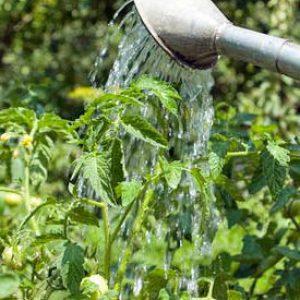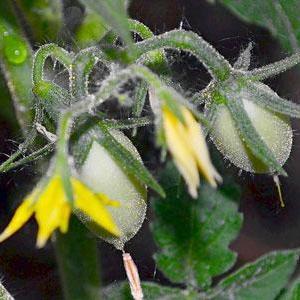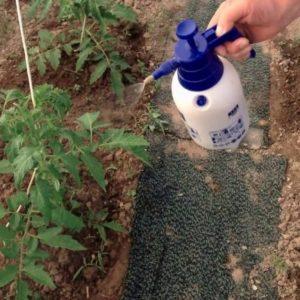Secrets of caring for tomatoes to increase yields: how to feed tomatoes during flowering and fruiting
With a deficiency of nutrients and essential micro- and macroelements, tomatoes slow down in growth, can shed ovaries and even get sick. Experienced tomato growers know - feeding will come to the rescue!
About how to feed tomatoes during flowering and fruiting and how to do it - in our article.
The content of the article
Nutrition of tomatoes during flowering and fruiting
 When the tomatoes are in bloom and begin to pour, watering the plants plays an important role. Do not think that the more you water the tomatoes, the better. Practice shows that moderation is needed in everything. Plants with a strong root system have the ability to extract moisture from the lower soil layers. From an excess of moisture, the roots rot.
When the tomatoes are in bloom and begin to pour, watering the plants plays an important role. Do not think that the more you water the tomatoes, the better. Practice shows that moderation is needed in everything. Plants with a strong root system have the ability to extract moisture from the lower soil layers. From an excess of moisture, the roots rot.
But not only watering important for tomatoes. During flowering and fruiting, they need additional feeding. An experienced gardener will quickly notice the changes: the lack of trace elements in tomatoes immediately affects the appearance of the plants. The leaves begin to curl, change their color and structure. And at this stage it is important to quickly navigate and take measures to correct the situation.
Proven feeding methods
We have reviewed the best folk recipes for feeding tomatoes. Let's consider them.
Boric acid
Top dressing with the addition of boric acid works effectively on tomatoes. For its preparation, dilute 0.5-1 tsp. boric acid crystals in 10 liters of water. A good result is obtained by processing the leaves with the resulting solution. The aboveground part of the plants is irrigated with a spray bottle.
Important! The crystals are diluted in a small amount of hot water, and then poured into the rest. This is because boric acid does not dissolve in cold water. There is a risk of burning the plants during processing.
Herbal infusions
The most convenient way to prepare such infusion is in a barrel or large bucket. The container is filled with grass by two-thirds. Any grass mass will do: cut grass, chopped weeds. Great if you can find nettles. Gardening professionals believe that adding it to the infusion guarantees a good result. A container with grass is poured with water and left to ferment for 10-14 days, covered with a lid. To improve the process, you can add 1 liter of garden soil to the mixture.
Attention! The fermentation smell will be unpleasant. Choose a place where he will not disturb you.
For feeding, dilute 1 liter of infusion for 10 liters of water. Each bush is fertilized with one liter of working solution.
Yeast starter
Yeast is an excellent growth promoter for tomatoes. Making a starter is easy. You will need:
- 100 g fresh yeast;
- 3 liters of water;
- 70 g sugar.
The mixture is left to ferment for 3-5 days. At the end of fermentation, the leaven is ready. It is used for root dressing. 0.5 l of the starter culture is diluted in 10 l of water. The resulting solution is watered with tomatoes at the root - 0.5-1 liters under a bush.
Mineral dressing
Among all minerals, tomatoes are most in need of fertilizers:
- nitrogen - ammonium nitrate or ammonium sulfate;
- phosphoric - superphosphate;
- potassium - potassium salt and potassium chloride.
Fertilizers from different manufacturers contain different dosages of minerals, so the use rate is recommended to be taken from the manufacturer's instructions from the package. It is extremely important to adhere to the manufacturer's dosage, otherwise the plants can be "burned".
Mineral dressing is convenient.They are used as in the greenhouse and a greenhouse under the film, and in the open field. And even when growing tomatoes on the balcony.
Chicken manure and horse manure
Some gardeners feed tomatoes with fertilizer based on chicken manure or horse manure. The ingredient is diluted at the rate of 0.5 liters per 10 liters of water. The resulting solution is watered with 0.5 liters of tomatoes per bush.
But there are those who advise not to use manure and droppings during the growing season of tomatoes, referring to the fact that after fertilizing the bushes, tops grow, and not fruits.
Read also:
The best recipes for bread dressings for tomatoes.
How to spray tomatoes for the ovary.
Features of agricultural technology of the "Money bag" variety for a better harvest.
Ash infusion
This infusion is fed to tomatoes both at the root and on the leaves. For infusion, 1 liter of wood ash or ash is brewed in 5 liters of boiling water. When the mixture has cooled, it is diluted at the rate of 0.5 liters of the mixture per 5 liters of water.
Foliar dressing gives the best results for this recipe.
Humates
This is a special class of agrochemicals. They combine both fertilizer and bioactive additive. There are two types of humates:
- Sodium humate. It is a kind of growth and development stimulant. Possessing adaptogenic properties, it helps tomatoes cope with unfavorable conditions - cold snap, drought, increased moisture.
- Potassium humate. An analogue of a complex fertilizer.
Reference. Humates are produced on the basis of manure, bottom sediments (silt), peat and organic waste. It is an environmentally friendly and efficient top dressing.
Manufacturers produce humates in liquid form, powder and tablets. The most popular among tomato growers are liquid humates. Dilute them according to the instructions (usually 1-2 tsp per 10 liters of water). Consumption for root application - 0.5 l of working solution. Can be fed by leaves.
Important! Top dressing with humates increases the yield up to 30% and promotes longer fruiting.
Milk iodine tincture
This tincture gives especially good results at the stage of fruit ripening. It increases their sugar content and reduces the risk of plant disease with late blight. Take 1 liter of milk (the fat content of the product is not important) and add 10 drops of pharmacy alcoholic tincture of iodine to it.
The solution is mixed with nine liters of water. Water 0.5 l under each tomato bush.
Top best purchased drugs
Let's see what preparations tomato growers consider the best:
| Name | Description | average price |
| "Kemira lux" | Soluble complex fertilizer with microelements. Dilute 20 g of the drug in 10 liters of water. Consumption - 0.5 liters per tomato bush. Application frequency:
|
70-80 rubles. per 100 g |
| "Solution" | Complex water-soluble fertilizer. Suitable for root and foliar applications. Preparation: 20-40 g of the drug per 10 liters of water. Consumption - 0.5 liters per bush. Frequency - once every 2 weeks. |
80-100 rub. for 500 g |
| "Calcium nitrate" | Special nitrogen-calcium composition. Easily soluble in water. The working solution is prepared from 10-20 g of the drug per 10 l of water. For open and closed ground, the same frequency of application is recommended - 2-3 times during the flowering and fruiting period with a break of 2 weeks. | RUB 45-60 per 1 kg |
Attention! An excess of fertilizer will have a bad effect on the condition and yield of tomatoes. It is better not to feed the plants than to overfeed.
Top dressing scheme
Gardeners agree that it is optimal to do top dressing:
- Root. During flowering and fruiting of tomatoes, it is better to make three of them: by buds, by flowers, by fruits.
- Foliar (by leaves). It is advisable to make them three to four times, alternating with root ones.
In total, during the flowering and fruiting period, tomatoes are fertilized up to 7 times.
Important! Before fertilizing, it is advisable to first water the tomato bush.
Reviews
Here's how gardeners say about fertilizing tomatoes:
Olga, Izhevsk: “My tomatoes have yielded very well and for a long time this summer.Thanks to the liquid peat humate. "
Ira, Serpukhov:“A neighbor at the dacha fed the greenhouse tomatoes with cow dung, the plants became fat. I never use mullein at home. If only after composting. I like herbal dressings, I do them regularly. I take nettles and green grass from lawn mowing. I insist with water for two weeks. I water tomatoes both outdoors and in the greenhouse. The yield is good. "
Tatiana, Bryansk region:“Of the purchased fertilizers, I liked Fertika Finnish Universal. After him, the tomatoes turned out to be fleshy. Previously, this could not be achieved. I tried to feed the tomatoes with mullein - I didn't like it. A lot of greenery has grown, but the fruits are not reflected. "
Let's sum up
Top dressing is needed for tomatoes to build up a good harvest. The gardener does not need to spend money to buy fertilizers. They can be prepared by yourself from the available components at hand and not use chemistry. Wood ash from a fireplace and weeds from a vegetable garden are also suitable. They make the most correct and environmentally friendly fertilizing for tomatoes.
The fertilizing discussed in the article will certainly help to saturate the plants with useful substances, improve fruit setting, prevent diseases and increase the yield of tomatoes by 20-30%. Tempting, isn't it?